by Winding Pathways | Aug 19, 2014 | Flowers/Grasses, Nature
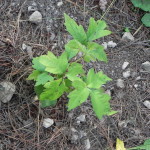
These beneficial wildlife plants are the bane of unsuspecting gardeners.
Few plants cause as much human misery as poison ivy. Direct contact with the allergenic oil on its leaves or in its roots or stems can cause itchy welts in people.
Poison ivy is as tricky as it is common. Most outdoor people know to avoid it when it’s growing rapidly in spring but forget about it the rest of the year. We’ve gotten a poison ivy rash in nearly every month and most commonly get a good case in late spring when we’re working in the yard and garden. The plant is sappy then and when we’ve inadvertently pulled the roots out of the ground without wearing gloves we’ve gotten rashes. But late summer into fall are also prime times to get poison ivy rash. Birds eat the seeds which they drop in excrement and the new plants take hold in summer’s lushness. Gardeners encounter the new plants during deep-season weeding or fall “tuck-in” time.
Poison ivy is common in urban and rural areas. It is highly adaptable, preferring light shade, but also thriving in full sun and dense shade. Usually it hugs the ground, but it can grow to a shrub six feet tall or a vine that climbs to the top of trees. It likes to hide inside the greenery of urban hedges. Poison ivy usually has three leaves and is often confused with five-leafed Virginia creeper.
Humans must come in physical contact with the plant or its oil (urushiol) to end up itching. Inhaling smoke laced with poison ivy is asking for trouble. People generally contract poison ivy from tools, pets, farm animals and clothes that have contacted the plant. Any season is game. The Centers for Disease Control and Prevention has an excellent page on range of the plant and its cousin poison oak as well as poison sumac, symptoms, prevention, and care of tools that have been used in extricating poison ivy. Avoiding contact is the best way to prevent a rash. If bare skin comes in contact with the plant immediately wash the area with plenty of soap and warm water.
Despite the misery it causes humans, poison ivy is valuable to wildlife. Deer and cottontails readily eat it, especially in the winter. Birds devour the seeds helping to spread it around in their droppings. Birds like to perch on small end branches of trees so, we’ve learned to look up and assess the likelihood of contacting poison ivy shoots before plunging into a weedy flower bed.
The plant has another merit. Its leaves are one of the first to turn color in early fall, often to a brilliant red. Spot a patch of bright red leaves close to the ground in September and chances are they are either poison ivy or nonpoisonous smooth sumac.
by Winding Pathways | Aug 15, 2014 | Nature, Trees/Shrubs
We are lucky to have four species of oak trees on our property. Huge white oaks hug the north end with a few red oaks scattered between them. Two medium sized black oaks live close to the house and a young bur oak is just beginning to cast shade south of the house.
Millions of other homeowners are also fortunate to have oaks shading their property. They are one of the most widespread trees, and are beautiful, sturdy, valued by wildlife and long lived. A white oak could shade the ground and feed squirrels for up to 400 years. Some species, like red oaks, grow relatively quickly and tolerate moderate shade while most other oaks, like our bur, need full sun and grow slowly.
About 600 oak species are found naturally across the northern hemisphere. Approximately 90 species live in the United States. China boasts around 100 species, and Mexico is probably the world leader in oak diversity with at least 160 species. They have been widely planted in temperate regions including many places where they don’t occur naturally.
Oaks are members of the beech family with the genus name Quercus. It’s rather easy to distinguish an oak tree, but determining just what oak species a tree belongs to can be tricky. Many oaks hybridize with similar oak species and a tree may have characteristics of each parent. Sometimes the shape of an oak leaf near the top of a tree may be shaped differently from a counterpart lower down.
Non-showy oaks flower in mid spring about the time leaves appear. Male blooms are slim, drooping and green or tan in color. Each female flower is a solitary spike. People allergic to the wind borne pollen generally suffer in the spring.
Throughout history oak wood has been readily used by people. Even wine corks are made from the bark of Portuguese oaks. Oak was widely used in the construction of sailing ships. It’s said that the oak sides of the USS Constitution were so tough that British cannonballs bounced back. That’s where the nickname Old Ironsides came from! Oak is the traditional wood for liquor aging barrels but today it is most commonly used for hardwood flooring and furniture. Few woods produce more fireplace heat than oak.
Squirrels are just one of the wildlife species that love acorns. Among the host of other wild animals that relish acorns are deer, bears, woodchucks, wild turkeys and blue jays. However, oak leaves or acorns can be toxic to cows that eat too many. Tannin is the bitter element in oaks and acorns and long ago humans learned how to remove it to create delicious food. Each fall we look forward to harvesting acorns. Few foods are as delicious as maple syrup on warm acorn muffins.
Subscribe to Winding Pathways to learn how to process acorns into food.
For further Information
One of the most fascinating tree books ever written was published back in 1948. It is a two volume set by David Culross Perry. One volume covers trees of eastern North America while its counterpart describes western species. If you spot it for sale at a garage or used book sale snap it up.
Websites, apps and books abound that help identify and learn about trees. Our favorite websites are from the National Arbor Day Foundation at and the US Forest Service. Our favorite tree identification book is the Sibley Guide to Trees.
by Winding Pathways | Aug 12, 2014 | Labyrinths, Nature, Reflections/Profiles, Wonderment
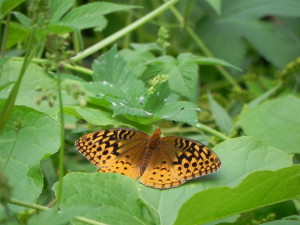
Resting.
Recently, a friend and I took a brisk walk punctuated by a “pucka brush” adventure. We ambled along a wide trail under trees, jumped over poison ivy, picked off stick tights, sweated and stepped in “scat”. Charming.
We spotted the most diminutive caterpillars ever – now officially named “toddler wooly bears”.
We paused to admire what I tentatively have identified as Polygonia comma (Eastern Comma) and Speyeria aphrodite (Aphrodite Fritillary) butterflies as well as Monarchs and Swallowtails.
Through the camera lens we captured Joe Pyeweed and goldenrod blooms against the dark woods green.
And, I came home feeling tranquil.
The afternoon was consumed with computer work, trying to figure out how to….you name it. Thank goodness Winding Pathways has an excellent Web Developer who, even at long distance keeps in close contact and fixes the “whatevers.” By the end of the evening I felt drained.
So, I wondered, what is tranquility? Defined as “The quality or state of being calm,” I have decided that tranquility has many faces. A person can be active yet tranquil – think running meditations or wandering though the “pucka brush”. The repetitious movements of ironing or gardening can be tranquil. Sitting quietly and watching industrious insects gather nectar and pollen, hummingbirds chase each other and rabbits forage on clover all can be tranquil.
Any activity that neutralizes the angst, the compulsive “gotta do” state that we regularly live in and transforms it to a sense of peacefulness can promote tranquility. But, this state of being is ephemeral and elusive.
Just as the early spring flowers bloom and disappear within a few weeks, tranquility will seem to pass all too soon. Are we failures? No. Like these tender blossoms it lies just beneath the surface. And, like the spring ephemerals, tranquility will return especially when we “tend the soil” so to speak. We can choose to access the state of tranquility any time.
Herein lies the elusive. To allow tranquility to touch us takes a certain amount of awareness and surrender. Allow the active mind to flow into settled stillness. Not emptiness – stillness.
Think of the ocean buffeted by winds and storms, cris-crossed by boats and littered with floating detritus. The surface is often rough and turbid. Not far below, currents flow more slowly and water begins to clear. Objects sink through the water. Heavier ones land on the bottom. Lighter ones, like silt, plants and plastics, hang suspended somewhere in between. At the depths of the ocean submarine currents move slowly influenced by density and temperature differences. Our thoughts can be like that, too. At some point our minds like water become clear.
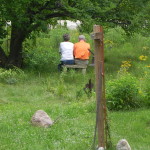
Connected to each other and the earth, we can find tranquility.
To best access the state of tranquility, remember its ephemeral nature. We are not “less” when we are un-tranquil. We are just “on the surface” of daily activities. Grace and ease lie just below this patina of our exterior nature. So, we can choose to surrender into tranquility and be the ease, grace, joy and empowerment we are meant to be.
For me connecting with nature helps me attain tranquility. With the Laughing Labyrinth in our front yard the transition is usually simple. Then, I flow with ease, grace, joy and empowerment – even when I have stepped in scat.
by Winding Pathways | Aug 6, 2014 | Bugs, Flowers/Grasses, Nature, Trees/Shrubs, Weeds, Wonderment
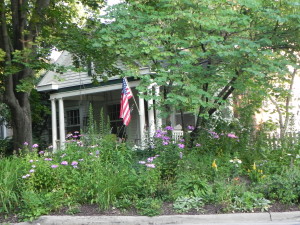
This lovely landscape adds beauty to the neighborhood and welcomes pollinators.
Worldwide concern over dramatic declines in honeybee populations the past few years have hit the news. These intriguing and highly beneficial insects pollinate thousands of species of flowers, but media reports lead us to believe that they are the only pollinator and the disappearance of honeybees will leave plants unable to pollinate. The result will decimate human food supplies.
That’s only true in context. Honeybees are Old World natives introduced to North America in early settlement days. Before Columbus there were no honeybees on the continent, but obviously plants pollinated, thanks to dozens of other insect species as well as a few mammals.
Honeybee loss is of huge concern to anyone who likes to eat because of the way our society farms. Immense monoculture orchards and fields lack habitat for native pollinators. Farmland is often doused with insecticides. Farmers place honeybee colonies in the midst of vast almond and fruit orchards as well as other crops to pollinate these giant biological deserts that can’t support other pollinator species.
Fortunately, there are ways homeowners can welcome pollinators to their yards.
Become a beekeeper. It’s a fascinating hobby that yields satisfaction, pollination and delicious honey. Learning beekeeping takes effort and may not be legal in some cities. Look for future Winding Pathways blogs on beekeeping or contact your local extension agent or nature center to learn about beekeeping classes and locate experienced beekeepers. Beekeepers are usually eager to mentor newcomers.
Create pollinator homes. Mason bees are efficient, fascinating pollinators that are easy to attract to yards. While they do not yield honey they do get the pollination job done. Mason bees lay eggs in cavities in wood and readily use nesting structures placed in a yard. Most garden supply companies sell mason bee “houses” made of many tubes joined together. A mason bee home can be easily made from scrap wood. We made ours from several pieces of scrap 2X6 lumber screwed together to form a thick short piece of artificial tree. We drilled holes in it for the bees to raise their larvae, painted it and hung it from our deck. A few bees used it the first season with more moving in the next year. Google “Mason Bee” and choose from the many plans.
Create a pollination pocket, or PP, in the yard. Many pollinators only need a small patch of tall vegetation to hide in and raise their young. Mowed and sprayed lawns lack pollinator habitat. Often vast subdivisions are so manicured that hardly a beneficial insect can live there. So, to create the simplest PP just stop mowing a strip of lawn and let grasses and weeds grow tall there. The bigger the patch the better but even a 10 or 20 foot long and two foot wide strip will house pollinators.
The downside of letting a patch of lawn grow up is that plant species diversity will be limited and problem weeds may grow. Pollinators love weeds, but neighbors don’t. Be creative. The greater the diversity of flowers the more colorful the PP will be, the more beneficial insects it will attract and the more neighbors will like it. Our PPs include a wide variety of native grasses and wildflowers. Because we live in Iowa many of our plants are native prairie species but we also encourage some ornamental exotic flowers. One of our favorites is the cupplant. It’s tall and gangly but dozens of insect species love it. So do goldfinches and hummingbirds! On most sunny summer days tiger swallowtail butterflies and bumblebees visit it. Goldenrods and milkweeds are also outstanding pollinator plants.
A PP can serve many purposes. Tall, colorful patches of flowers and grasses can form walkway boundaries – winding pathways – in the yard and also can put steep or rough hard to mow areas to good use. A PP does more. The plants sink roots deep into the earth holding soil and creating space for rainwater thus reducing runoff. For a tranquil evening activity, sit quietly near a pollination pocket with a pair of binoculars that will focus closely and enjoy the constant coming sand goings of dozens of species of intriguing insects.
Take a step in creating a wondrous yard by creating a pollinator pocket. It will add summer color to the yard and invite all sorts of delightful and helpful insects to cohabit your space.
by Winding Pathways | Jul 14, 2014 | Flowers/Grasses, Nature, Weeds
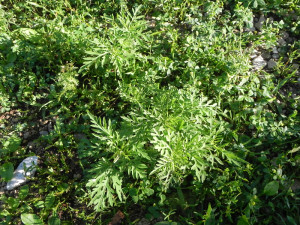
Common Ragweed
Late summer is the dreaded hay fever season! Ragweed is the prime culprit.
Two species of ragweed account for most of the misery. Both are annuals that reseed each year. The seeds only need a bit of bare ground to sprout. They are not fussy, thriving in nearly any type of soil.
True to its name, Common (sometimes called Eastern) Ragweed can be found nearly anywhere people live, especially cities. It can be a prostate plant hugging the ground or sidewalk edge or grow to two or three feet tall on the edge of a yard. Giant (sometimes called Western) Ragweed is less common in suburban and urban areas and can grow to upwards of eight feet tall. It’s abundant on the edge of farm fields where it often forms large thickets. In urban areas Giant Ragweed is most likely found in industrial areas and along railroad tracks. Despite their names either species can be found nearly anywhere in North America, where they are a native plant. Unfortunately ragweed has been introduced to Japan.
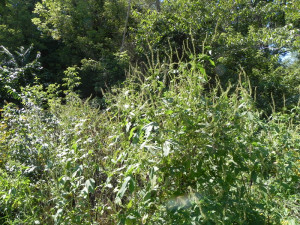
Giant Ragweed
Ragweed causes human suffering because in late summer plants produce green flowers that release millions of pollen grains to the wind. Allergic people react after breathing in the tiny grains, which can blow for miles from the parent plant.
Goldenrods are frequently blamed for causing hay fever because of an unfortunate coincidence. They bloom during hay fever season. Goldenrod flowers are a bright yellow, designed to attract pollinating insects. They do not release pollen into the air and are unjustly blamed for causing human misery.
Despite causing hay fever, ragweeds have ecological value. They are a pioneer weed that quickly becomes established on bare soil. Roots hold the soil, preventing erosion. Within a few years ragweeds usually vacate the spot as more stable perennials move it. Ragweed seeds are devoured by many bird species such as quail.
As a general rule any plant that produces unshowey flowers is a wind pollinator that could cause human allergies. This includes many grass and tree species as well as ragweed. In contrast plants that produce colorful showy flowers are normally insect pollinated and don’t cause sneezing.
by Winding Pathways | Jul 14, 2014 | Bugs, Nature, Pests
Many people believe that long cold winters freeze ticks to death so abundance of these pests will be lower the following summer. That isn’t always the case. Plenty of ticks survived the frigid 2013/2014 winter and have appeared on pets, wildlife, and people the following spring and summer.
Ticks are more than mere pests. They can carry serious diseases. Several species are common in any given part of the country. Most are larger species that are about the size of a pencil eraser. Less easy to spot are tiny deer ticks that can carry the debilitating Lyme Disease. Sometimes they are so small that people are bitten without even realizing it.
The recreational, inspirational, and exercise benefits of being outdoors are immense, and no one should stay inside for fear of ticks, but everyone should take precautions to reduce odds of being bitten by a tick and catching a nasty disease.
Ticks are arachnids. They have eight legs, rather than an insect’s six. Fortunately, insect repellents also repel ticks, and some special sprays are designed to kill them. Repellents are generally safe to apply to the skin but don’t last long. Tick killing sprays are meant to be applied to clothing, not skin, and tend to remain effective through a few washings. We use a combination of both when outside in areas where we suspect ticks lurk.
After spending time outdoors everyone should conduct a tick check on their body. Although commonly believed, ticks do not drop down on people from overhead branches. They normally cling to a plant and simply step onto a person, dog, or wild animal when it brushes by. Usually a tick will walk around on a person, sometimes for hours, before biting. Ticks found walking on a body pose no health hazard and can be plucked off and flushed down the toilet. Only those ticks that have penetrated the skin pose a health hazard. If a dug in tick is found on the body it’s a good idea to consult a medical authority and follow the advice given.






